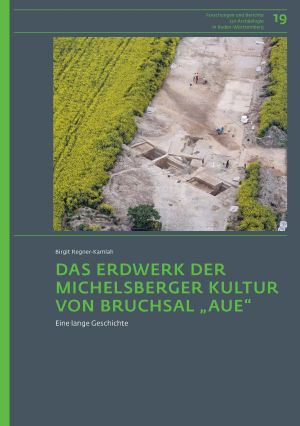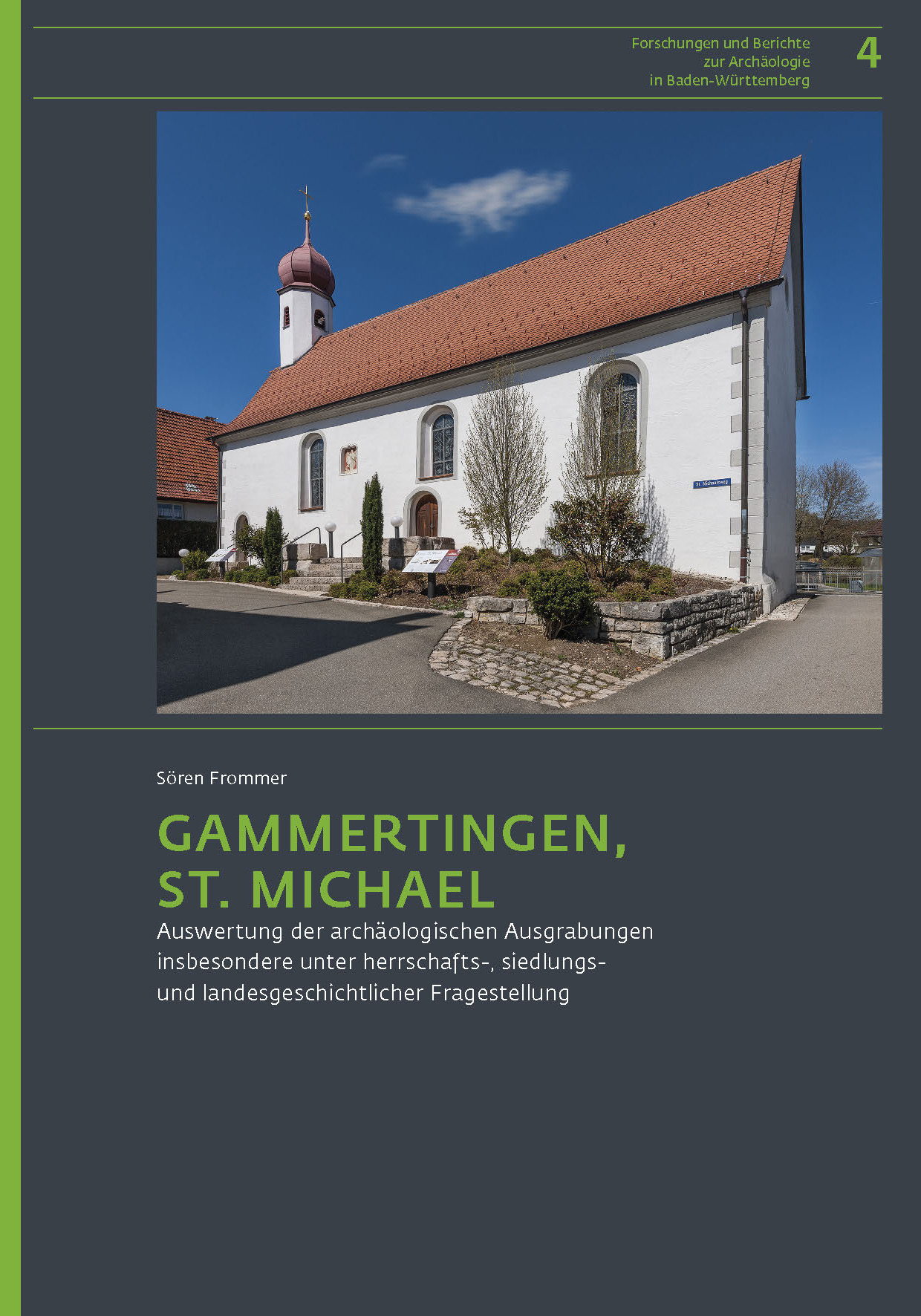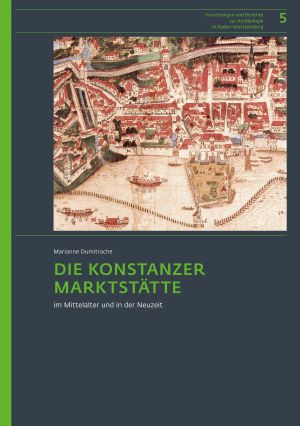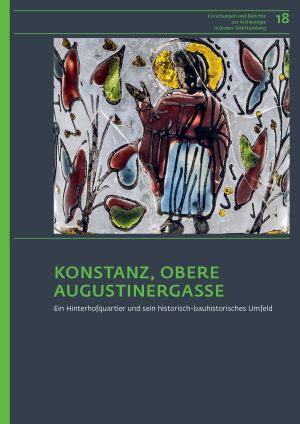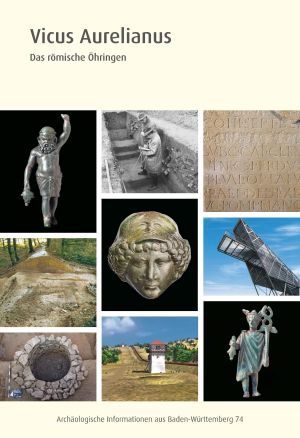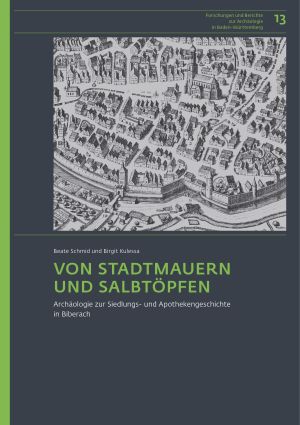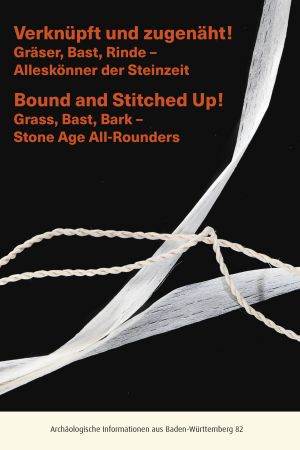Wolf, Claus
Das Erdwerk der Michelsberger Kultur von Bruchsal „Aue“: Eine lange Geschichte
In the "Aue" area on the north-eastern edge of the small town of Bruchsal in Baden, a double ditch from the Michelsberg culture (around 4300–3600 BC) was discovered in 1986 by aerial survey. In 1987–1993, the ditches, which were preserved over a length of around 550 m, were archaeologically investigated almost in their entirety. A surprising discovery were six burial pits at the edge and under the base of the outer ditch with the skeletons of nine children and seven adults, some in a regular and some in an irregular position.
The carefully documented excavation allowed a detailed reconstruction of the building history of the ditch complex. The analysis of the features revealed that the earthwork never existed in its appearance as it is today, but that it is the result of various anthropogenic and natural transformations over a period of six centuries. However, the discussion about the function of the Michelsberg earthworks cannot be settled in Bruchsal “Aue” either – there are indications of a profane settlement use with a defensive character as well as of cultic or ritual activities.
Gammertingen, St. Michael: Auswertung der archäologischen Ausgrabungen insbesondere unter herrschafts-, siedlungs- und landesgeschichtlicher Fragestellung
Located on the edge of the late medieval town of Gammertingen, the unimposing chapel of St. Michael is a relic of a high nobility estate of the 10th–12th centuries AD, whose roots go back to the Merovingian period. Interdisciplinary analyses of the archaeological excavations give an extraordinary insight into the emergence and development of a medieval dynastic estate and at the same time indicate the role of local tradition already in the early days of aristocratic development. Starting immediately with the first massive church built around 980 AD, the chapel is used as a dynastic burial site by the resident high nobility. But also for later phases, St. Michael’s chapel provides first-hand information, for example on the epochal conflict between Gammertingen’s town lord Dietrich von Speth and Duke Ulrich of Württemberg in the 16th century.
Additional infomations you find here.
Die Konstanzer Marktstätte im Mittelalter und in der Neuzeit
Constance is one of the towns in Baden-Württemberg that survived World War II largely undamaged. Due to extensive archaeological remains, which are particularly well preserved under the embankments of the former lake shore, the historic centre of Constance became one of the focal points of the federal state's archaeological heritage management since the 1980s. From 1989 to 1992, large-scale excavations were carried out in the area of the “Marktstätte” (marketplace), which stood out by an exceptional density of archaeological features and large quantities of find material. The detailed analysis of the features and finds presented in this volume provides new insights into the urban development during the Middle Ages and early modern times. In addition to building development, the focus is on medieval land reclamation, harbour construction and early modern marketplace use.
Additional infomations you find here.
Konstanz, Obere Augustinergasse: Ein Hinterhofquartier und sein historisch-bauhistorisches Umfeld
The historic centre of Constance, with its historic buildings and excellently preserved archaeological remains, has been one of the focal points of archaeological heritage preservation in the state of Baden-Württemberg since the 1980s. Large-scale excavations were carried out in 1986–1987 in the backyard area of the most important north-south axis in the city, the Hussenstraße. Originally settled in the second half of the 11th century, a higher social class neighbourhood had developed here by the 14th century. The archeological investigations were evaluated in an interdisciplinary approach, starting with the urbanistic and historical context of the residential area and the evaluation of the findings, continuing with the presentation of the finds made of leather, glass, ceramics and metal, and ending with the scientific analysis of the animal bones and insect remains, which allow conclusions about the diet of the inhabitants and the hygienic conditions.
Vicus Aurelianus: Das römische Öhringen
Öhringen around 200 AD: Several hundred soldiers in two forts guard the nearby Limes. Their families, traders and craftsmen live in the surroundings of the military camps. The settlement – named vicus Aurelianus – is an important sentinel of the Roman Empire on the border with the Germanic tribes. The importance of the site has been recognized by archaeology already during the 18th century. Christian Ernst Hanßelmann, one of the pioneers of archaeology of the Roman provinces, led the first excavations. He uncovered wall sections and recovered coins, ceramics, inscriptions and other finds. The Romans are still present in Öhringen today. The UNESCO World Heritage of the Roman Limes, the Weygang Museum, the Limes Views and the State Horticultural Show in 2016: We are reminded of the vicus Aurelianus in many ways.
Von Stadtmauern und Salbtöpfen: Archäologie zur Siedlungs- und Apothekengeschichte in Biberach
For centuries, the town of Biberach preserved its largely undisturbed town centre with a considerable number of late medieval buildings. This volume presents the results of two excavations at very different locations within the medieval urban structure. The analysis of the excavation on Viehmarktplatz focuses on questions of the beginning of the settlement and the development on its periphery, and thus on the first town fortifications. The investigation of the building at Marktplatz 7, on the other hand, is concerned with the building history and use of a late medieval town house in a central location between the church and the market. In the course of its long history it was used by a pharmacist, among others. By presenting and interpreting the features and the finds from both excavations, the authors create a multifaceted picture of everyday life in a medieval town.
Verknüpft und zugenäht! Bound and Stitched Up ! Gräser, Bast, Rinde – Alleskönner der Steinzeit / Grass, Bast, Bark – Stone Age All-Rounders
The textiles found at the prehistoric lake dwelling settlements were true all-rounders. A wide range and variety of raw materials reveal an astonishing variety of applications. The interdisciplinary research project “THEFBO” (2018–2021) investigates the cultural and historical significance of textiles for the early agricultural communities. This booklet accompanies the touring exhibition and contains comprehensive articles from the project partners as well as interviews covering the diversity of the theme.



